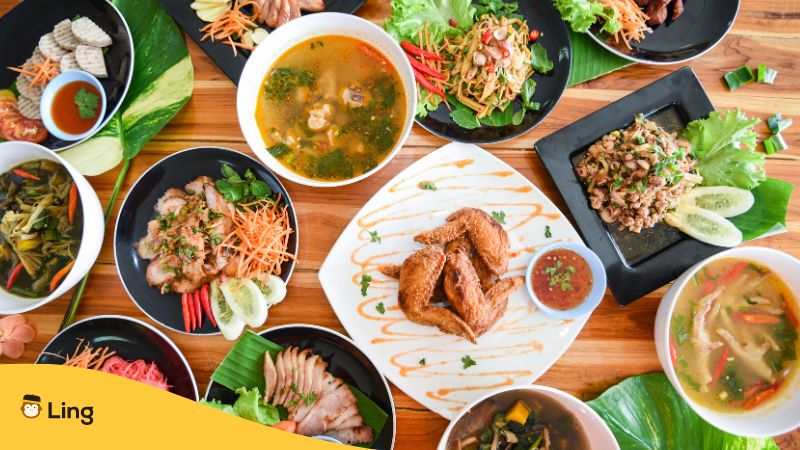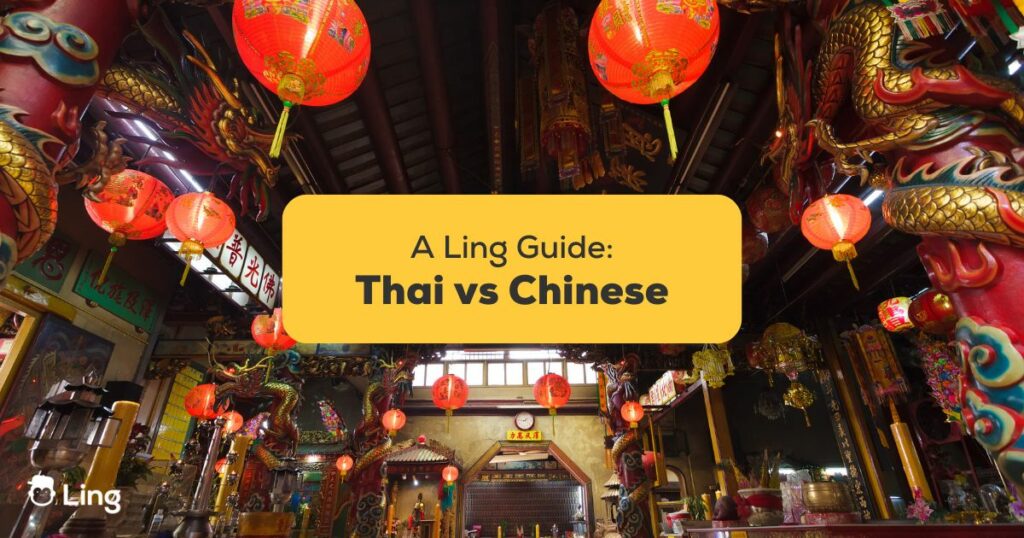It’s trivia time! Did you know that Thailand is home to the largest overseas Chinese community globally? With nearly 10 million Thai Chinese, or ชาวไทยเชื้อสายจีน (chaawthay chʉ́asǎay ciin), they make up almost 15% of the population, making them the largest minority group in the country!
And if you’re familiar with Bangkok, chances are you’ve heard people speaking Chinese amidst the bustling crowds at iconic destinations like Siam Paragon or Wat Arun. This popularity owes much to Thailand being a well-loved destination for Chinese tourists, who make up a significant portion of visitors to the country!
So you see, the Thai and Chinese cultures share more than geographical proximity; they intertwine in various aspects. In this article, I’ll tell you all the interesting information related to the Chinese and Thai languages as we explore their unique similarities and differences.
Thai vs Chinese: Language
Official Language Status
First things first, let’s talk about the Thai language ภาษาไทย (phaasǎathay) and the Chinese language 汉语 (hànyǔ)! Thai is the official language in only one country, Thailand. However, it’s also spoken as a minority language in places like Laos, Cambodia, Myanmar, and Malaysia.
On the other hand, Chinese is the official language in not one, not two, but three countries! These countries are China, Taiwan, and Singapore. And speaking of Singapore, it’s worth mentioning that Chinese isn’t the sole official language there. Rather, it’s one of the four official languages, alongside English, Malay, and Tamil.
Additionally, while Chinese doesn’t have official status in Malaysia, it’s widely spoken throughout the country. Plus, the Chinese dialect, Cantonese 廣東話 (wong2 dung1 waa2), is the official language of Hong Kong and Macau. So you see, while Thai is prevalent in Thailand and its neighboring countries, Chinese has quite the international presence!

Language Family
Thai is a Tai language of the Kra-Dai language family, a language family that’s found in mainland Southeast Asia, southern China, and northeastern India. Other than Thai, languages that fall under this family include Lao (ພາສາລາວ), Shan (ရှမ်းဘာသာ), Isan (ภาษาอีสาน), and more. But that’s not all, of course! There’s a total of 95 languages in this language family, with 62 of them being part of the Tai branch.
Now, what do all the languages in this family have in common, you may ask? Well, they’re all tonal languages! That means they rely on pitch to differentiate lexical or grammatical meaning. A total of approximately 93 million people speak Kra-Dai languages, and 60% of them are Thai speakers!
On the other hand, Chinese is a Sinitic language of the Sino-Tibetan language family, a language family that thrives in East Asia, Southeast Asia, Central Asia, and South Asia. Other than Chinese, languages that hail from this family include Burmese (မြန်မာဘာသာ), some Tibetan languages, and more.
You may think that the Kra-Dai’s language family’s 95 languages is a lot, but get this – the Sino-Tibetan language family boasts more than 400 languages! It’s second only to the Indo-European language family, which consists of languages like English, Spanish, French, and more, in terms of the number of native speakers.
A total of around 1.4 billion people speak Sino-Tibetan languages. And out of all of them, around 1.3 billion people, or around 15% of the global population, speak a variety of Chinese, such as Mandarin, Wu Min, Yue, and more, as their first language!

Demographics
As mentioned earlier, Thai is most spoken in, of course, Thailand, though it’s spoken as a minority language in countries like Laos, Cambodia, Myanmar, and Malaysia. But how exactly does this translate in numbers, you may ask? Well, you’ll find your answers in this section.
Thai is spoken by nearly 70 million people! It’s spoken by Thai people from all walks of life, whether they’re Central Thais, Mon in Central Thailand, Thai Chinese, or anything else. Moreover, many northern and northeastern (Isaan) Thais are bilingual in Thai and their respective regional dialects.
And aside from being spoken as a minority language in various Southeast Asian languages, Thai is also spoken as a second language by minority ethnic groups within Thailand! These include the Hmong, Karen, Shan, Kuy, and more.
As for Chinese, I’ve already mentioned previously that there are almost 1.3 billon speakers, so that’s significantly more than the number of Thai speakers. In fact, it’s around a whooping 18 times more than the number of Thai speakers!
These include Chinese speakers not just from China, but also Taiwan, Singapore, Malaysia, Hong Kong, Macau, and of course, other overseas Chinese communities in both Southeast Asian countries like Vietnam and Indonesia, as well as in other countries such as the United States, the United Kingdom, Canada, and more.

Grammatical Rules: Similarities
Now, let’s delve into Thai and Chinese grammatical rules! Let’s start with talking about their similarities. First of all, both Thai and Chinese follow the Subject-Verb-Object (SVO) order in basic sentence structures.
So, if you already know Thai or Chinese and are trying to learn the other, it shouldn’t be too difficult for you to do so! Here’s an example sentence to show this:
- Thai: ผู้ชาย P̄hū̂chāy (Subject) กิน kin (Verb) ข้าว k̄ĥāw (Object) – The man eats rice.
- Chinese: 男人 Nánrén (Subject) 吃 chī (Verb) 饭 fàn (Object) – The man eats rice.
Secondly, both Thai and Chinese generally lack verb conjugation. Unlike in English, where you either use, for example, the verb “read” or “reads” depending on pronoun and tense, they don’t conjugate verbs based on tense, person, or number! Here’s an example sentence to illustrate this:
- Thai: เขา K̄heā (He/she) อ่าน x̀ān (reads) หนังสือ h̄nạngs̄ụ̄x (book) – He/she reads books.
- Chinese: 他 Tā (He/she) 读 dú (reads) 书 shū (book) – He/she reads books.
Lastly, both Thai and Chinese lack plural forms for nouns. This means that unlike in English, where you add the letter ‘s’ at the end of a noun to mark a plural, plurals in Thai and Chinese are indicated by context or additional words. Here’s an example sentence to demonstrate this:
- Thai: เด็ก Dĕk (child) เล่น lèn (play) บน bn (on) สนาม s̄nām (field) – Children play on the field.
- Chinese: 孩子 Háizi (child) 在 zài (at) 操场 cāochǎng (playground) 玩 wán (play) – Children play at the playground.
Grammatical Rules: Differences
Now, let’s talk about differences in Thai and Chinese grammar, starting with the most obvious one: Thai and Chinese script. While Thai uses its own unique script, the Thai script or อักษรไทย (àksɔ̌ɔn thay), Chinese primarily uses Chinese characters or 汉字 (hàn zì). To demonstrate just how different the scripts are, here’s the word ‘man’ written in both Thai and Chinese scripts:
- Thai: ผู้ชาย P̄hū̂chāy (The man)
- Chinese: 男人 Nánrén (The man)
Another notable difference between Thai and Chinese lies in their pronouns. While Chinese pronouns are pretty standard, with ‘you’ 你 (nǐ) being used in everyday situations or 您 (nín) in formal contexts, Thai pronouns are far more diverse.
The choice of the pronoun for ‘you’ in Thai, such as คุณ (khun), แก (kɛɛ), or มึง (mʉŋ), varies depending on the relationship between the speaker and the listener, ranging from formal to casual levels. That means you need to be especially careful which pronouns you use in Thai, which is a far more nuanced aspect compared to Chinese!
Last but not least, the placement of Thai and Chinese counters in sentences differs. While the counter appears before the noun in Chinese, it pops up after the noun in Thai! So, for Chinese, it’ll be like “two people (men)” in English, but for Thai, it’ll be something like “men two people”! Here’s an example sentence to show just that:
- Thai: ผู้ชาย P̄hū̂chāy (The man) สอง s̄xng (two) คน khn (people) – Two men.
- Chinese: 两 Liǎng (two) 个 gè (measure word) 男人 nánrén (men) – Two men.

Thai vs Chinese: Food
Of course, language isn’t all there is to Thai and Chinese – there’s food too, another really important aspect of culture! Both Thai and Chinese food are so delicious that it’s hard to pick between the two.
Thai cuisine is known for its extensive range of flavors, blending sweet, sour, and salty elements with aromatic herbs and spices. It often incorporates fish sauce too, giving dishes a unique taste. Popular Thai dishes include pad Thai, pad krapao, pineapple fried rice, and many more.
Chinese cuisine is just as illustrious too! Chinese cooking places emphasis on a balance of flavors and textures, showcasing delicate stir-fries, heartwarming soups, and flavorful sauces. Most popular and loved Chinese dishes include sweet and sour pork, dumplings with various fillings, roast duck, and so much more!
Ready To Learn Thai And Chinese?
If you want to learn Thai or Chinese, or even better, challenge yourself by trying to learn both languages, you should totally try out the Ling app! Unlike your traditional textbooks and classes, the Ling app lets you learn hard languages the easy way, through interactive and engaging gamified bite-sized lessons. So, what are you waiting for? Download the Ling app from the App Store or Play Store today!




































































